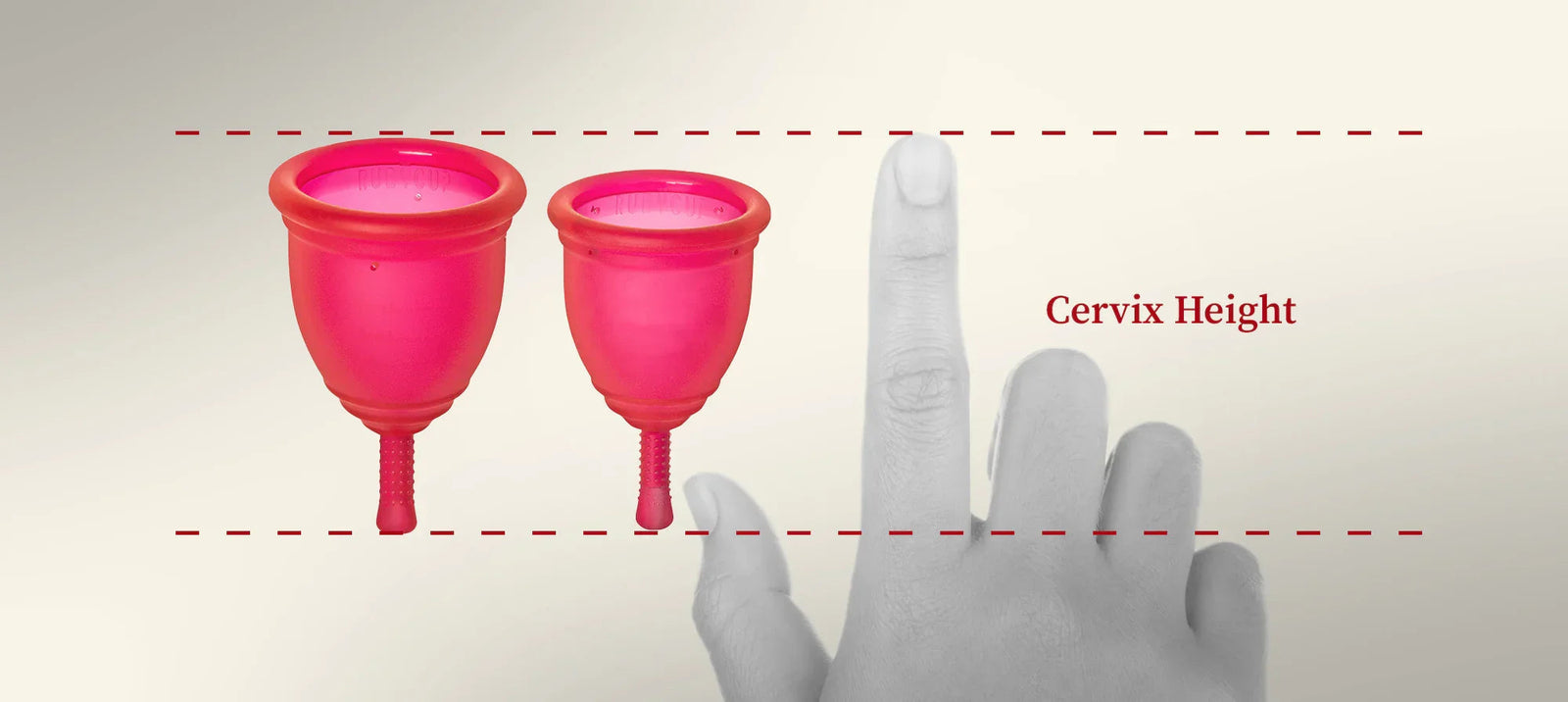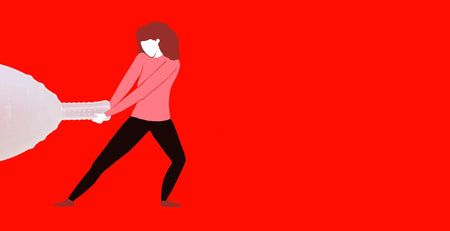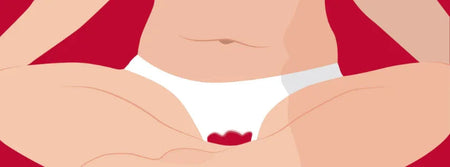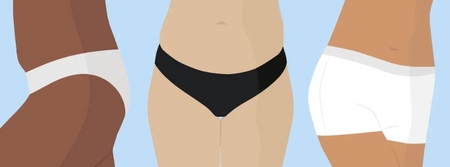Ever wonder if your cervix is high, low, or average height? Probably not. Our cervical height is not a daily topic of conversation for most of us. But if you are making the switch to a menstrual cup or wanting to find the most comfortable, fuss-free way to handle your monthly flow, you might want to pay a little bit more attention to the height of your cervix. Read Ruby Cup’s guide to learn more about a high cervix, how to measure your cervical height, and the best menstrual cups for your high cervix.
This article is written by clinician Amy Harris. Read more about Amy Harris at the end of the article.
What does cervical height mean?
Cervical height can be a helpful piece of information to know when choosing the right period cup for you.
Cervical height is how high or deep inside your vagina your cervix lies. Your cervix is the mouth to your womb or uterus. Your cervix sits at the top of your vaginal canal. Cervical height is the distance from the tip of your cervix to the outside of your vagina (your vulva).
The average cervix measures 4-5 centimeters. The length of your cervix changes during pregnancy and slightly during your menstrual cycle.
The average length of the vaginal canal is 9-10 centimeters. Vaginas are muscular tubes which can stretch wide and long enough to accommodate a penis, sex toys, and even a baby.
How do you measure cervical height?
Measuring the height of your cervix is really very easy. Ruby Cup loves helping people with vaginas, cervixes, uteruses, and periods learn more about how their amazing bodies work. Knowing the height of your cervix and which way your uterus tilts can be helpful for:
- Choosing the right-sized, most comfortable menstrual cup
- Inserting your menstrual cup, menstrual disc, tampon, or diaphragm to the right location and preventing leaks or unplanned pregnancies
- Finding the right positions for sex that feel great for your body
Remember that your cervix lies deep inside your body, connecting your vagina to your uterus. That is why doctors use a tool called the speculum to help them find and see your cervix during a pelvic exam. Not to worry, you can find your own cervix without a speculum by following our step-by-step guide and this helpful diagram:

- Wash your hands.
- Find a comfortable position. Some people find putting one leg up on the toilet or chair works better – others like to bend their knees wide and squat slightly.
- Insert your index (pointer) finger into your vagina. The opening to your vagina lies in between your labia (lips) which you may need to spread apart to find the opening. Your vaginal opening is in front of your anus (where poop comes out), but behind your urethra (where pee comes out).
- You can also sit on the ground with your legs spread wide in front of a mirror to locate your vaginal opening if you have a hard time finding it at first.
- The cervix lies at the very top of your vaginal canal. It will feel firmer, like the tip of your nose. Feel for a rounded donut shape.
- When you’ve located your cervix, take note of how far into your vagina you have inserted your index finger.
- If your labia touch your second knuckle on your index finger or below, then you have a high cervix.
- If your labia touch the second knuckle of your index finger or above, then you most likely have a low cervix.

Can Your Cervical Height Change?
Yes. With your menstrual cycle, your cervical height changes. When you ovulate (release an egg from your ovary each month), your cervix moves higher up into your vagina, lengthening your vaginal canal and changing your cervical height.
Right before and during your menses, your cervix is at its lowest height. So the best time to measure your cervical height for your menstrual cup is before or during your menses.
During sexual arousal, increased blood flow allows your vagina to stretch an additional 2-3 inches in length, and your cervix moves higher up into your vagina.
Your cervical height may also change after a full-term pregnancy and childbirth (vaginal or cesarean section). Even if you experience pelvic organ prolapse after childbearing or with age, most people can still enjoy all the benefits of using period cups.
And not to fear if you can’t find your cervix. Your doctor or health care provider is a great person to turn to for help. They can help you find your own cervix, tell you whether your cervix is high or low, and advise you on which size menstrual cup is right for you.
How are cervical height and the way my uterus tilts related?
Just like noses come in all different shapes and sizes, so do your vagina, uterus, and cervix. Your uterus can tilt forward towards your pubic bone (anteverted or anteflexed in medical lingo) or tilt backwards towards your tailbone (retroverted or retroflexed). The way your uterus tilts can change your cervical height.
Most commonly, the uterus tilts forward towards your pubic bone. Most people with a forward-tilting uterus will have a high cervix.
A quarter of people have a uterus that tilts back backward towards their tailbone (retroverted or retroflexed). Having a tilted uterus is a totally normal variation which does not impact your ability to have normal, healthy menstrual cycles, sex life, or pregnancy.
People with retroverted uteruses may have lower cervical heights and be more comfortable with smaller, shorter menstrual cups. Ruby Cup reviewed the best menstrual cups for people with a tilted uterus and low cervix to help you find the right cup for you.

Does having a high cervix make sex feel better or worse?
Not really. If you are sexually active and have a cervix, you may have experienced that deep, ache of a pain that can be a bit jarring if your partner thrusts too deeply into your vagina. This is what it feels like when your partner bumps into your cervix. This can happen whether you have a high or low cervix.
Because people with a high cervix have longer vaginal canals, they may be less likely to experience this uncomfortable cervical pain with deep penetrative vaginal intercourse than people with lower cervixes.
Regardless of your cervical height, if sex is painful or you think your partner is hitting your cervix in a way that does not feel good, talk to them. There are alternate positions for sex which can help you avoid this discomfort. If you sit on top of your partner you are able to control how deeply they thrust for example.
Does having a high cervix impact your ability to get pregnant?
No. Fertility and your ability to get pregnant is not changed by your cervical height. Some people trying to get pregnant pay attention to their cervical height (along with cervical mucus) to get a better idea when they might ovulate.
You may have heard some of your pregnant friends talking about cervical length. This is different from cervical height. Cervical length is how thick your cervix is.
The thicker your cervix is during pregnancy, the better able it is to stay closed until it is time to go into labor. Sometimes, with preterm labor, the cervix shortens too early in pregnancy. Cervical length and your risk for preterm labor don’t have anything to do with cervical height however.

Why is a period cup a good choice if you have a high cervix?
A period cup is a great choice for anyone with a period, regardless of your cervical height. There are many great reasons to choose period cups over traditional menstrual hygiene products like pads, tampons, and even period underwear. Our top reasons for making the switch are:
- Reduced landfill waste from tampons and pads
- Fewer toxic chemicals released into your body and the Earth by medical grade silicone period cups
- Lower risk of toxic shock syndrome
- Able to wear period cups for up to 8 hours without having to change
- Fewer leaks for those of us with heavy flow days
- Period cups last for up to 10 years so are a wallet-friendly investment
Want a zero-waste and fuss-free period? For every Ruby Cup purchased, we donate another one to a person without access to safe menstrual products. Get your Ruby Cup now.
Because people with a higher cervix have a longer vaginal canal, you may be able to wear larger or longer menstrual cups more comfortably than people with lower cervices. This means you may be able to go longer in between changing your menstrual cup.
What should you look for in a menstrual cup if you have a high cervix?
If you have a high cervix, you are able to insert your finger most or all of its full length into your vagina before you feel your cervix. That means you have a long vaginal canal. Therefore, you have plenty of room for:
- Medium to larger-sized menstrual cups
- Longer menstrual cups
- Period cups with stems or rings to help with removal
If you have a high cervix, you might accidentally insert a smaller cup too high in your vaginal canal. This might make it harder to remove. Not to fear though, a menstrual cup can not get lost inside of your vagina.
Another problem with using too small a cup with a high cervix, is that you might push it too close to your cervix. This could cause uncomfortable suction to form between the tip of your cervix and your period cup. It can take a little bit of practice to learn where a menstrual cup should sit.
That said, if you are a period cup newbie, never had sexual intercourse, or never had a child, a smaller-sized cup might feel more comfortable for you to start off with. That is why Ruby Cup offers its convenient Saver Pack and Duo Pack with both Medium and Small sizes. Having more than one size cup prepares you for both heavy and light flow days too. It can be tricky to figure out which size menstrual cup is right for you, so that is why Ruby Cup offers a return or full refund program for all cups. We want to make your period and using menstrual cups as fuss-free as possible!
FAQs
How do I know if I have a high cervix?
Most likely, you wouldn’t know that you have a high cervix unless your doctor or other health care provider told you so. Or, maybe you are curious about your own body and followed Ruby Cup’s step-by-step guide for how to measure your cervix.
You can find out if you have a high cervix by measuring the height of your cervix yourself. If you can insert your index (pointer) finger most of the way into your vagina (past the middle knuckle) before you feel your cervix, then you likely have a high cervix.
Which menstrual cup is best for a high cervix?
In general, a medium to larger-sized menstrual cup with a stem, ring, or knob to help with removal are the best type of menstrual cups for people with a high cervix.
Your long vaginal canal can sometimes make it tricky to remove a menstrual cup, especially if it is smaller or doesn’t have something to grasp onto when pulling it out of your vagina.
The taller and more narrow the cup is, the better able it is to form a seal with your vaginal walls. You want that seal to prevents leaks. The best-fitting period cups are those that are soft and flexible, like Ruby Cup’s hypo-allergenic medical grade silicone, that allows them to form a strong but comfortable suction with your vaginal walls. Ruby Cup Medium measures 68 milimeters (2.7 inches in length) and has a trimmable stem. Go for Ruby Cup Medium if you have a high cervix.
What’s the best menstrual cup for a high cervix and tilted uterus?
Most people with a tilted or retroverted uterus will have a low cervix. The best menstrual cups for a low cervix and a tilted uterus tend to be shorter in length. If they have a stem, it should be trimmable.
If you have a uterus which tilts forward towards your pubic bone (anteflexed or anteverted uterus), you more than likely have a higher cervix. You may feel more comfortable choosing a medium to larger-sized menstrual cup, or at least a longer one with a stem, knob, or ring to help you remove your period cup.
Learning more about your cervix before choosing a menstrual cup can help you find the right fit. As the period cup experts, we know it takes time to figure out which menstrual cup is going to work best for your body. That is why, as part of our global Buy One, Give One program, we not only donate menstrual cups but we also provide workshops, mentorship programs, and stigma-busting education to people with periods so they learn about their bodies and how to use menstrual cups. Our mission is to provide a sustainable menstrual health solution, and to deliver sound education on reproductive health and menstrual care. Join our Ruby Cup Revolution and help change attitudes, save our planet, and improve lives today!
Written by Amy Harris.
Amy Harris is a certified nurse-midwife with more than a decade of clinical experience in reproductive health clinics, hospitals, and private OB/GYN practices. Amy holds a Masters of Science in Maternal and Child Health from Harvard School of Public Health and completed her nursing and midwifery training at Yale School of Nursing and Boston University School of Public Health. Passionate about empowering women through health education, Amy puts her public health training to work as a dedicated women’s health writer.










